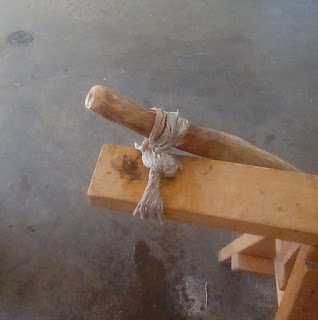Matches, lighter, ferro rod, char cloth and magnesium
Lighters are constructed of plastic which means that after their short life they become waste pollution. I also found that the gas lighter facilitates a laziness in finding the most easley igniting material in the area. I end up using more lighter fuel than is necessary. The sparker mechanism at the top tends to be a delicate device for outdoor use, along with materials that tend to rust.
Finally, bellow zero c, the fuel in a bic style lighter has a tough, unreliable time lighting.
There are many videos or suggestions people give on how to light a fero rod. The easiest and most effective way I have found to using the fero rod is of course you need a sharp edge, but simply plant the end of the fero rod onto a firm dry surface supporting the other end with your hand. If your only source is the fero rod, scape some fero off the rod, then give it a ferm score into the scraped fero scapes without lifting the rod from the surface. Have your dry grass ready to quickly ignite from the fero fire which won't last long.
The fero rod will often light birch with one quick, effective score; but some birtch barks are tougher to light tan others. With birch simply put a few loose sheets down on the firm surface and pin it with the end of you rod; then give the rod a firm score with an edge.
I have carried a small water tight container with cotton batting mixed with some tallow for an easy ignition source. Both a small ferro rod and the cotton batting, have a limit which does not outnumber the ignitions of the following solution.
Char cloth, produced from carbonized cotton cloth, but can also be produced from punk wood (which i prefer far less), lights by the smallest spark had from the smallest piece of fero rod, knife spine, carbon steel, &c. Curl cloth, spark it, take the now slow burning square of char cloth and put it in a handful of dry gras. Curl the grass around the cloth, and blow on the grass. The grass will burst into flames in short order so have your bundle of kindle already ready to put on to of the lit grass. The char works well for finishing of small bits of fero rod.
Make char by puting material into a titanium kettle you may have on hand. Put the lid on top of the pot and put the kettle on a fire; if you dont have a titanium kettle, any metal, near air tight container may be used. Cook until the smoke stops leaving your cook vessel. Let cool - without removing the lid.
Char cloth lights better than char punk, but cloth to make it is limmited. Supplement the char cloth with punk in the same fire start.
When using char cloth, bunch together instead of speading flat in the tinder. The better your tinder, the less char cloth needed.
When paired with pure magnesium filings, the mag/ferro rod is my favorite primary fire igniter source. The magnesium comes usually as a small brick with a small ferro rod glued to it. I suggest having each separate and keeping them as a pair in a pouch. As with the fero rod procedure above, push the end of the mag brick into a ferm surface and score off some sheets. Have easily starting source of dry plant material, like shavings of birch bark ready near by. Also have ready a couple hand fulls of dry spruce sticks (found near the base of the tree). Scrape a spark from the ferro rod into the magnesium pile then add the birch shavings, then add the extra birch shavings on the starting fire. Secure by carefully adding the spuce twigs.
A handful or dry grass with magnesium shaving to take a spark with a large bit of pine or spruce shavings scattered on the whole pile is sure to start a cook fire.
Hone on a sharp 90 degree angle to the spine of your knife so you can shave the magnesium and throw the spark from the ferro rod; if its not 90 degrees it can just be jagged or otherwise aggressive (in a pintch, just rough it on a rock). Honing on this angle to the spine is done by running your knife spine over the hone at a 90 degree angle by holding the handle with one hand and the blade in the other (CARFULLY). Hone until the spine edge develops a sharp corner on both sides.
My back up method is to use standard, strike anywhere matches (RedBird brand). I cut the match in half to save space, as I don’t need the added length, and fill a small water tight container with them; this container is held in a small pouch and hung around my neck. I do add a small amount of the striker strip to the case—you will save matches this way as rock strikes often fail.
Strike a match by aiming it at a sharp angle into the surface of the striker. Throw the match into the surface like a spear with the head leading. Let the head gently get deflected by the angled surface.
There are other primitive and simple ways of starting a fire that have many of the advantages that I value, like being water proof and simple in nature, like the steel striker, but they take much practice to become reliable and in the case of the striker, greatly benefit from carrying something additional , that is not water proof, like char cloth.


